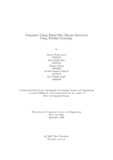| dc.contributor.advisor | Khondaker, Arnisha | |
| dc.contributor.author | Jayeb, Ahmad Wasiq | |
| dc.contributor.author | Hore, Alvin Rahul | |
| dc.contributor.author | Anjum, Ramisa | |
| dc.contributor.author | Sadeque, Sohana Sanjana | |
| dc.contributor.author | Auqib, Syed Tahsin | |
| dc.date.accessioned | 2023-10-16T07:02:45Z | |
| dc.date.available | 2023-10-16T07:02:45Z | |
| dc.date.copyright | ©2022 | |
| dc.date.issued | 2022-09-28 | |
| dc.identifier.other | ID 18101057 | |
| dc.identifier.other | ID 18101488 | |
| dc.identifier.other | ID 18101612 | |
| dc.identifier.other | ID 18101326 | |
| dc.identifier.other | ID 18101206 | |
| dc.identifier.uri | http://hdl.handle.net/10361/21845 | |
| dc.description | This thesis is submitted in partial fulfillment of the requirements for the degree of Bachelor of Science in Computer Science, 2019. | en_US |
| dc.description | Cataloged from PDF version of thesis. | |
| dc.description | Includes bibliographical references (pages 61-63). | |
| dc.description.abstract | Skin cancer have been the primary focus of this study, as they are one of the most
deadly diseases if not diagnosed and treated early. The study will make it possible
for computer science and medical science to work together to save lives. Machine
Learning, Deep Learning, and Image Processing have already been used to treat skin
conditions. Even though Deep Learning, Machine Learning, and Image Processing
have all been used in the past to treat skin diseases, we are trying to improve
the accuracy of this work by implementing new Image Processing and Machine
Learning models.In this study, pre-trained CNN models and combined pre-trained
Unet models are used to identify skin cancer and categorize the kind of cancer using
datasets with labeled pictures and classes. Although it may develop in areas of your
skin that are are not exposed to sunlight, skin cancer is an abnormal growth of
skin cells that most frequently affects skin that has been exposed to the sun. Skin
cancer is a kind of malignant melanoma, which is a type of cancer. The three most
common kinds of skin cancer are melanoma, basal cell carcinoma, and squamous
cell carcinoma. Approximately 301 people die from skin cancer each year. It will
be difficult to achieve high accuracy if you rely just on the dataset provided by
Kaggle. Recognize that not all datasets are balanced. Therefore, this study focuses
on identifying several methods to combine Deep CNN models with U-net to produce
deep CNN models that have the highest accuracy on both large and small datasets.
These methods mostly depend on supervised learning, which involves the use labels
and training data from datasets.This research aims to demonstrate how the best
model can be used to accurately diagnose Skin cancer and disorders at an early
stage. Here, we have classified a unique dataset using U-net model. We further
examined the CNN, U-net, pre-trained models, and other Unet based models for
example Attention Unet, ResUnet, R2Unet models accuracy to develop an optimum
model that may be further customized to a mobile application for widespread usage.
On more than 10000 photos of seven different skin conditions compared to healthy
skin, we built the architecture. On the basis of the images of our researched dataset,
we carefully compared our data and classified it. Finally, using ResUnet, which is
the best model for the task at hand, we accurately identified the Seven illnesses with
a 87.21% accuracy rate. | en_US |
| dc.description.statementofresponsibility | Ahmad Wasiq Jayeb | |
| dc.description.statementofresponsibility | Alvin Rahul Hore | |
| dc.description.statementofresponsibility | Ramisa Anjum | |
| dc.description.statementofresponsibility | Sohana Sanjana Sadeque | |
| dc.description.statementofresponsibility | Syed Tahsin Auqib | |
| dc.format.extent | 73 pages | |
| dc.language.iso | en | en_US |
| dc.publisher | Brac University | en_US |
| dc.rights | Brac University theses are protected by copyright. They may be viewed from this source for any purpose, but reproduction or distribution in any format is prohibited without written permission. | |
| dc.subject | Image processing | en_US |
| dc.subject | Deep learning | en_US |
| dc.subject | Machine learning | en_US |
| dc.subject | Attention Unet | en_US |
| dc.subject | R2Unet | en_US |
| dc.subject | ResUnet | en_US |
| dc.subject | Dense layer | en_US |
| dc.subject | Keras layer | en_US |
| dc.subject | Keras | en_US |
| dc.subject | TensorFlow | en_US |
| dc.subject | Validation | en_US |
| dc.subject | Accuracy | en_US |
| dc.subject | U-net | en_US |
| dc.subject | CNN | en_US |
| dc.subject | KNN | en_US |
| dc.subject | Skin cancer | en_US |
| dc.subject | SoftMax | en_US |
| dc.subject | Skin disease | en_US |
| dc.subject.lcsh | Pattern recognition | |
| dc.subject.lcsh | Optical data processing | |
| dc.title | Computer vision based skin disease detection using machine learning | en_US |
| dc.type | Thesis | en_US |
| dc.contributor.department | Department of Computer Science and Engineering, Brac University | |
| dc.description.degree | B.Sc. in Computer Science | |

